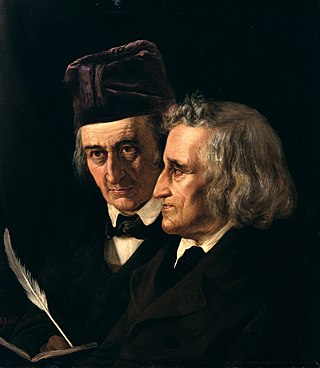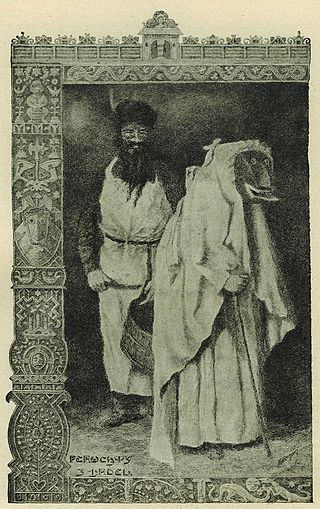
Jacob Ludwig Karl Grimm, also known as Ludwig Karl, was a German author, linguist, philologist, jurist, and folklorist. He formulated Grimm's law of linguistics, and was the co-author of the Deutsches Wörterbuch, the author of Deutsche Mythologie, and the editor of Grimms' Fairy Tales. He was the older brother of Wilhelm Grimm; together, they were the literary duo known as the Brothers Grimm.

The Brothers Grimm, Jacob (1785–1863) and Wilhelm (1786–1859), were German academics who together collected and published folklore. The brothers are among the best-known storytellers of folktales, popularizing stories such as "Cinderella", "The Frog Prince", "Hansel and Gretel", "Town Musicians of Bremen", "Little Red Riding Hood", "Rapunzel", "Rumpelstiltskin", "Sleeping Beauty", and "Snow White". Their first collection of folktales, Children's and Household Tales, began publication in 1812.

The Wild Hunt is a folklore motif occurring across various northern European cultures. Wild Hunts typically involve a chase led by a mythological figure escorted by a ghostly or supernatural group of hunters engaged in pursuit. The leader of the hunt is often a named figure associated with Odin in Germanic legends, but may variously be a historical or legendary figure like Theodoric the Great, the Danish king Valdemar Atterdag, the dragon slayer Sigurd, the Welsh psychopomp Gwyn ap Nudd, biblical figures such as Herod, Cain, Gabriel, or the Devil, or an unidentified lost soul either male or female. The hunters are generally the souls of the dead or ghostly dogs, sometimes fairies, valkyries, or elves.

Perchta or Berchta ('Bertha'), also commonly known as Percht and other variations, was once known as a goddess in Alpine paganism in the Upper German and also Austrian and Slovenian regions of the Alps. Her name may mean 'the bright one' and is probably related to the name Berchtentag, meaning 'the feast of the Epiphany'. Eugen Mogk provides an alternative etymology, attributing the origin of the name Perchta to the Old High German verb pergan, meaning 'hidden' or 'covered'. The exact origin or time of origin is unknown.

"Frau Holle" is a German fairy tale collected by the Brothers Grimm in Children's and Household Tales in 1812. It is of Aarne-Thompson type 480.
In Scottish and Northern English folklore, a shellycoat is a type of bogeyman that haunts rivers and streams.

Grimms' Fairy Tales, originally known as the Children's and Household Tales, is a German collection of fairy tales by the Grimm brothers or "Brothers Grimm", Jacob and Wilhelm, first published on 20 December 1812. Vol. 1 of the first edition contained 86 stories, which were followed by 70 more tales, numbered consecutively, in the 1st edition, Vol. 2, in 1815. By the seventh edition in 1857, the corpus of tales had expanded to 200 tales and 10 "Children's Legends". It is listed by UNESCO in its Memory of the World Registry.
"The Three Little Birds" is a German fairy tale collected by the Brothers Grimm, tale number 96. The story is originally written in Low German. It is Aarne-Thompson type 707, the dancing water, the singing apple, and the speaking bird. The story resembles Ancilotto, King of Provino, by Giovanni Francesco Straparola, and The Sisters Envious of Their Cadette, the story of the 756th night of the Arabian Nights.
Deutsche Mythologie is a treatise on Germanic mythology by Jacob Grimm. First published in Germany in 1835, the work is an exhaustive treatment of the subject, tracing the mythology and beliefs of the ancient Germanic peoples from their earliest attestations to their survivals in modern traditions, folktales and popular expressions.

Deutsche Sagen is a publication by the Brothers Grimm, appearing in two volumes in 1816 and 1818. The collection includes 579 short summaries of German folk tales and legends.

The Schrat or Schratt, also Schraz or Waldschrat, is a rather diverse German and Slavic legendary creature with aspects of either a wood sprite, domestic sprite and a nightmare demon.

Erika Eichenseer née Jahn was born in Munich in 1934 and lives in Regensburg, Bavaria. She has led the revival of interest in Franz Xaver von Schönwerth, the 19th-century folklorist who collected fairy tales in the Upper Palatinate region of northern Bavaria, having found 500 tales of his in the municipal archives of Regensburg, most of which had never been published before. She is a writer, a poet, an authority on the folk heritage of the Upper Palatinate, and a well-known storyteller.
Franz Xaver von Schönwerth was a Bavarian civil servant who was an important collector of folklore in the Upper Palatinate region.
Feldgeister or Korndämonen are corn spirits from German folklore. Feldgeister often are also wind spirits causing lightning and rain.

The Bergmönch is a mountain spirit from German folklore. He is also known as Meister Hämmerling.
The Buschgroßmutter is a legendary creature from German folklore, especially found in folktales from the regions Thuringia, Saxony, former German-speaking Silesia and the former German-speaking parts of Bohemia. She is called various regional names such as Pusch-Grohla and Buschmutter in Silesia, 's Buschkathel and Buschweibchen in Bohemia, Buschweiblein and Buschweibel in Silesia again. Buschweibchen, Buschweiblein, and Buschweibel all mean "shrub woman", with Weibchen, Weiblein or Weibel being the diminutive of Weib, "woman".
The Irrwurz, Irrwurzel or Irrkraut is a legendary plant from German-speaking countries. In France it is known as herbe d'égarement among other names.
The Uhaml is a spirit from German folktales. It was known among the former Germans of Bohemia and Silesia, now part of the Czech Republic and Poland respectively, particularly in the former Iglau language island of Bohemia. The Uhaml is an airy sprite, a ghost, or possibly some kind of demonic bird. Nothing is known about its appearance other than it having horse feet.
The Klagmuhme or Klagemuhme is a female sprite from German folklore also known as Klagmutter or Klagemutter. She heralds imminent death through wailing and whining and is thus the German equivalent of the banshee.
The Heimchen is a being from German folklore with several related meanings.










